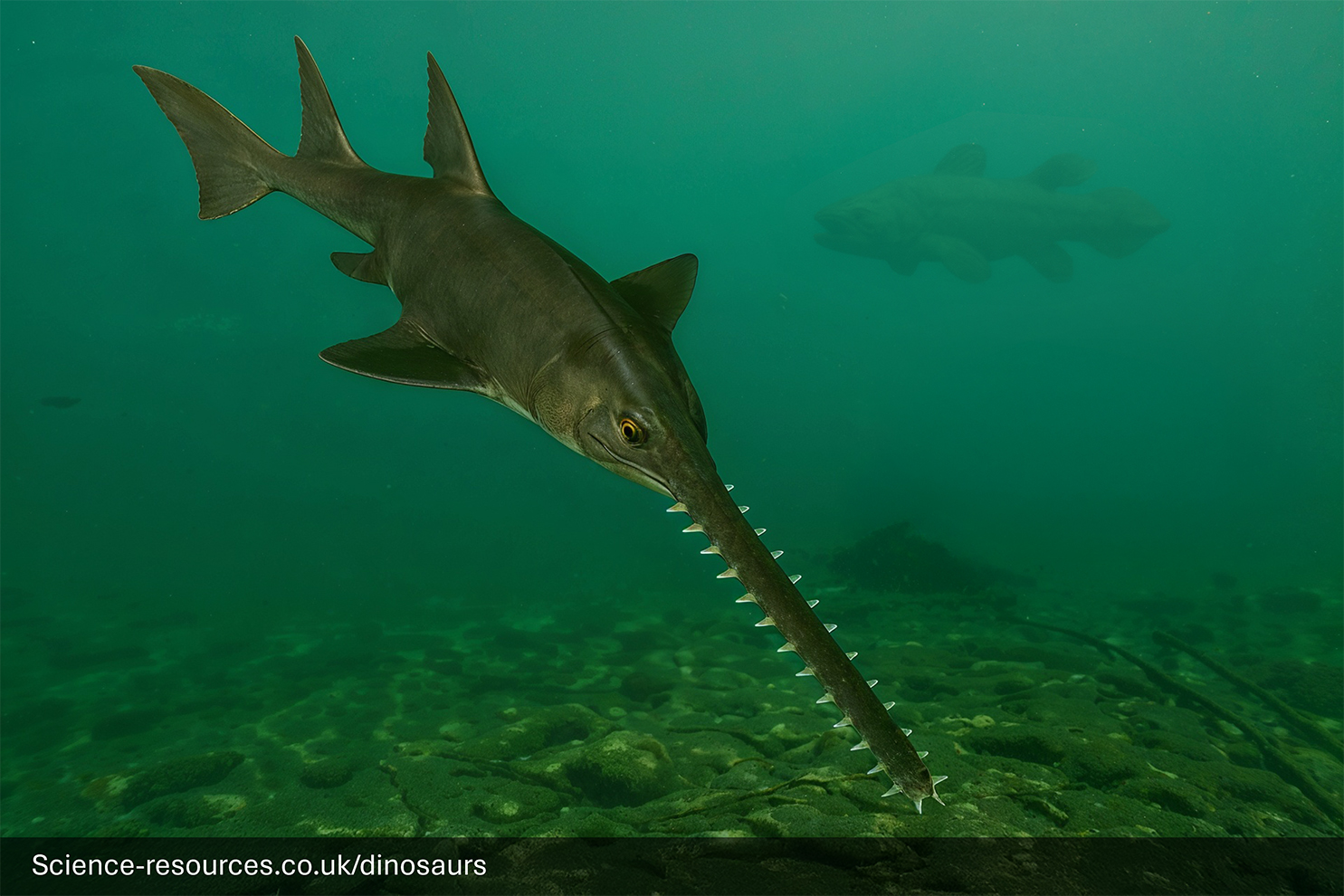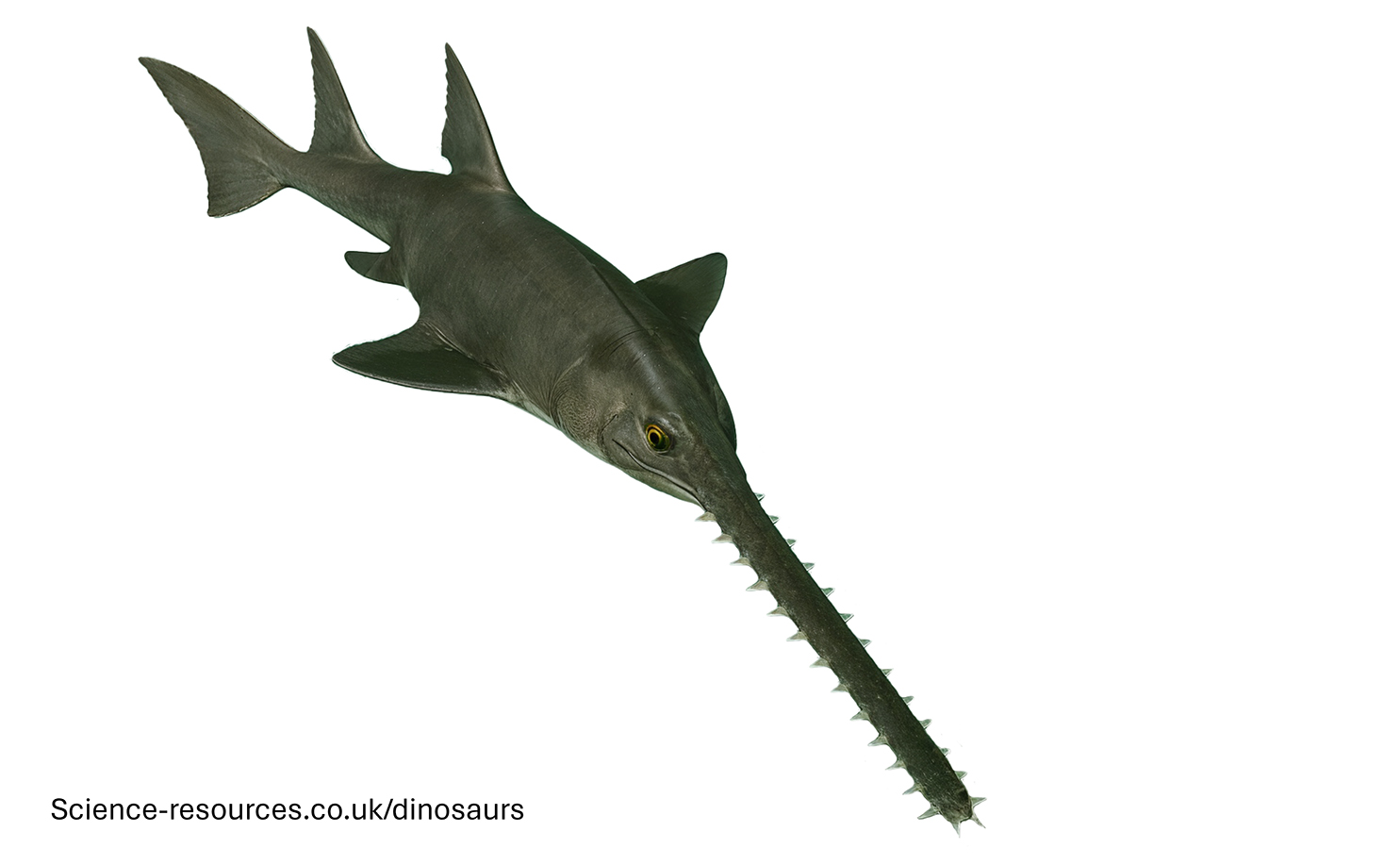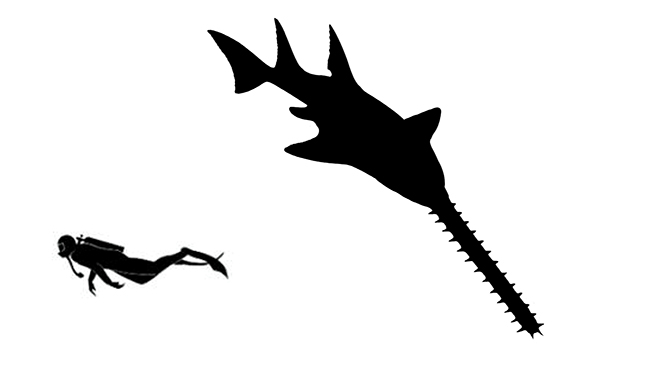Dinosaurs A:Z | O
You may also be intrested in: Free Dinosaur games
Dinosaurs and other prehistoric animals:
Onchopristis (Giant Saw)
You may also be intrested in: Free Dinosaur games
Onchopristis is an extinct species of large sawfish-like ray that lived in the water. Its name means "Giant Saw" because of its long, saw-like snout. It belonged to a group called cartilaginous fish, which includes modern sharks and rays, but it was not a dinosaur. Onchopristis lived during the Cretaceous period, which began about 145 million years ago and lasted until about 66 million years ago. Well-preserved fossils have been found in Africa, particularly in the Kem Kem beds of Morocco. Length: Onchopristis could reach up to 8 meters (26 feet) long. Onchopristis looked similar to a modern sawfish but had some unique features. It had a long, saw-like snout with sharp teeth on the edges, which helped it catch prey. Its body was streamlined for swimming, and it had powerful fins to navigate through the water. Onchopristis Generative AI Notification: Some elements of this image have been created or enhanced using AI technology. To find out how we create all our dinosaurs, click here. Onchopristis was a carnivore, meaning it ate meat. It likely fed on fish and other small marine animals, using its saw-like snout to slash and catch its prey. Onchopristis lived in the oceans, from coastal areas to deeper waters. Its fossils have been found in Morocco, indicating it had a wide geographic distribution. Specimens of Onchopristis have been associated with the jaws of Spinosaurus in North Africa, indicating that Spinosaurus would have preyed upon Onchopristis. Illustrations typically depict Spinosaurus capturing Onchopristis with its powerful jaws, highlighting their predator-prey relationship. This representation illustrates the dynamic interactions within the Cretaceous period's ecosystem.
What is an Onchopristis?
When and where did Onchopristis live?
How big was Onchopristis?
Appearance

What did Onchopristis eat?
Where did Onchopristis live?
What preyed on Onchopristis?
 A Spinosaurus hunting an Onchopristis
A Spinosaurus hunting an OnchopristisInteresting facts
Pronounced: on-co-pris-tis Name Means: "Giant Saw"


Onchopristis Facts
Length: 8 metres (26 feet)
Weight: 70 - 150 kilograms (150-330 lb)
Diet: Carnivore (Fish, small marine animals)
Time: Cretaceous
Habitat: Oceans, rivers
Fossils Found: Europe, North America, Africa
Onchopristis belonged to the cartilaginous fish, a group that includes modern sharks and rays. They were well-adapted to life in the ocean.
Onchopristis was a fast swimmer. It moved by using its streamlined body and undulating its fins. Its powerful fins were used for steering and swimming quickly through the water.
Onchopristis had a streamlined body, a long, saw-like snout, and powerful fins. Its large snout with sharp teeth helped it catch fish and other sea creatures. It was well-adapted to life in the ocean and was a skilled hunter.
Q1: What is Onchopristis?
A1: Onchopristis is an extinct genus of sclerorhynchoid, or sawskate, that lived during the Cretaceous period in North Africa, Europe, and North America.
Q2: When did Onchopristis live?
A2: Onchopristis lived approximately 125 to 94 million years ago, from the Barremian to the Cenomanian ages.
Q3: What are the notable features of Onchopristis?
A3: Onchopristis had a long, blade-like rostrum lined with sharp teeth, which it likely used to impale or slash at prey.
Q4: How many species of Onchopristis are known?
A4: There are two recognised species: Onchopristis numida and Onchopristis dunklei.
Q5: Who named Onchopristis and when?
A5: Onchopristis was named by the German palaeontologist Ernst Stromer in 1917.
Q6: What does the name Onchopristis mean?
A6: The name Onchopristis is derived from the Ancient Greek words "ónkos" (barb) and "prístis" (saw), referring to its saw-like rostrum.
Q7: Where have Onchopristis fossils been found?
A7: Fossils of Onchopristis have been discovered in coastal and fluvial deposits in North Africa, Europe, and North America.
Q8: What was the diet of Onchopristis?
A8: Onchopristis likely fed on smaller fish and other marine organisms, using its rostrum to capture and kill prey.
Q9: Was Onchopristis prey for any larger predators?
A9: Yes, Onchopristis was prey for Spinosaurus, as evidenced by fossils found in association with Spinosaurus jaws.
Q10: How large could Onchopristis grow?
A10: Onchopristis could reach up to 8 meters (26 feet) long.
Which family of reptiles did Onchopristis belong to?
How did Onchopristis move?
What were the unique features of Onchopristis?
Onchopristis FAQ
You may also be intrested in:
Tags: How big was Onchopristis, Onchopristis, Onchopristis, what did Onchopristis eat, what does Onchopristis mean, Onchopristis, Onchopristis facts